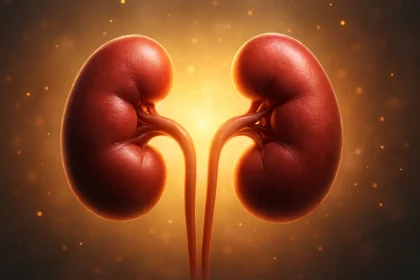A new kidney therapy is emerging as a source of hope for patients facing a silent yet devastating genetic mutation. This condition refers to a rare, but significant, subtype of chronic kidney disease with a hereditary (monogenic) origin, caused by a malfunction in the UMOD gene. This mutation leads to the production of defective proteins within kidney cells, triggering a dangerous cycle of inflammation and fibrosis—an internal scarring process that gradually impairs kidney function.
Although chronic kidney disease (CKD) affects around 10% of the global population, only a small fraction of cases stem from genetic causes. Within this subset, a form known as ADTKD, linked to mutations in the UMOD gene, stands out. This condition may account for up to 25% of hereditary kidney disease diagnoses, excluding more common forms such as polycystic kidney disease and Alport syndrome.
The Special Role of MANF Protein
Researchers have discovered that MANF (Mesencephalic Astrocyte-derived Neurotrophic Factor) functions as a “cellular rescue agent” for those with ADTKD-UMOD. It promotes:
- Autophagy (the cell’s internal cleaning process),
- Protection of mitochondria (the cell’s energy factories),
- Reduction of excessive inflammation, particularly in the cGAS-STING pathway.
When MANF is activated, the kidney becomes capable of eliminating some of the defective proteins produced by the mutant gene. Furthermore, the inflammatory response is mitigated and fibrosis slows down—which opens the door to preventing more serious complications.
Advanced Model Studies
To validate MANF’s role, scientists used a genetic editing technique (CRISPR/Cas9) to create mice with mutations similar to those found in humans. In different variations of the UMOD gene, increased MANF levels led to reduced toxic waste accumulation, less inflammation, and lower levels of kidney fibrosis.
In addition, researchers employed advanced imaging technologies, such as PET/CT scans with specific radiotracers, to detect inflammation and free radicals. This monitoring confirmed that treated animals maintained healthier cellular markers over time.
From Discovery to Clinical Application
The impact of this discovery is so promising that the University of Washington (WashU) recently opened a clinic dedicated to ADTKD. The center is led by Dr. Ying Maggie Chen, one of the original study’s authors and an international authority on the subject.
Beyond offering personalized care for patients with this genetic form of kidney disease, the clinic also employs cutting-edge cellular and molecular models. The goal is to accelerate the development of new therapies. Among them, MANF protein stands out as the leading candidate for future clinical application.
Why This Is Innovative
The new kidney therapy centered on MANF represents a groundbreaking step for those living with ADTKD-UMOD. Until now, no drug existed that could fix the genetic error or remove the accumulated defective proteins. As a result, current treatments typically focus on slowing the disease progression or rely on dialysis and transplants in later stages.
The experimental therapy with MANF, however, offers the potential to address the issue at its root cause. This could prevent the damage from becoming irreversible.
Even more intriguing is MANF’s potential in treating other diseases, since many chronic conditions also involve the accumulation of misfolded proteins. In theory, this same “cell-cleaning power” could help manage other conditions that currently lack effective treatments.
Paths Toward the Future
For patients and families with a history of hereditary kidney disease, the outlook is encouraging. In the near future, genetic tests could help identify UMOD mutations early. If the MANF therapy reaches the market, targeted treatment could be offered before kidney failure begins.
In this context, staying informed about ongoing research is essential to unlocking new doors in the fight against this class of diseases.
Conclusion
The study on MANF protein sheds light on how certain hereditary kidney diseases develop. Moreover, it introduces a new type of treatment focused on cellular cleansing and mitochondrial protection, the energy centers of the body.
If successful, this approach could help many people avoid invasive procedures and preserve kidney function longer. As a result, monogenic kidney disease could become a much more manageable challenge.
Reference
Source: This content is based on the article “MANF stimulates autophagy and restores mitochondrial homeostasis in kidney injury induced by mutant UMOD” by Chengyuan Wu et al., published in Nature Communications (2023). Available at: https://www.nature.com/articles/s41467-023-42154-0.
You Might Also Like
Posts Recomendados
Carregando recomendações...



